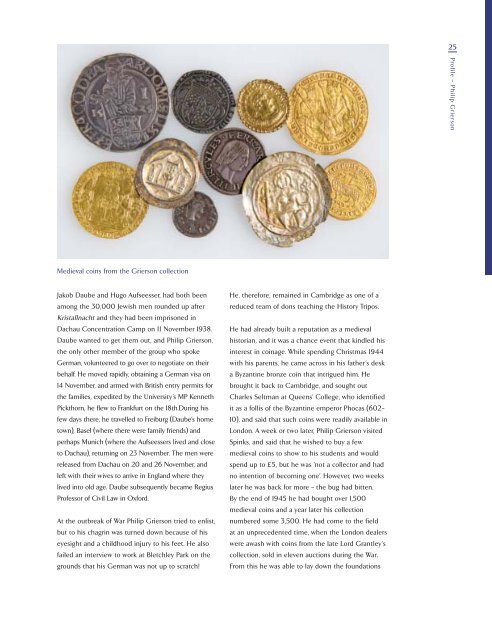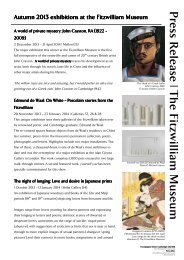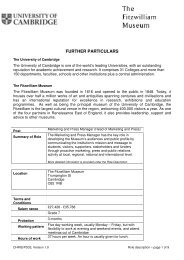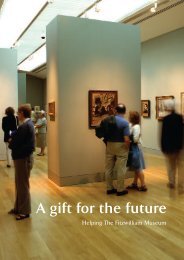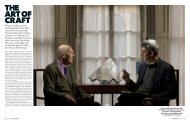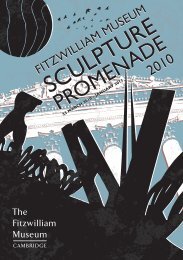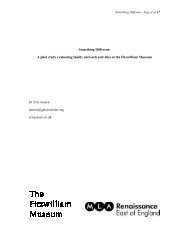The Fitzwilliam Museum - University of Cambridge
The Fitzwilliam Museum - University of Cambridge
The Fitzwilliam Museum - University of Cambridge
Create successful ePaper yourself
Turn your PDF publications into a flip-book with our unique Google optimized e-Paper software.
Medieval coins from the Grierson collection<br />
Jakob Daube and Hugo Aufseesser, had both been<br />
among the 30,000 Jewish men rounded up after<br />
Kristallnacht and they had been imprisoned in<br />
Dachau Concentration Camp on 11 November 1938.<br />
Daube wanted to get them out, and Philip Grierson,<br />
the only other member <strong>of</strong> the group who spoke<br />
German, volunteered to go over to negotiate on their<br />
behalf. He moved rapidly, obtaining a German visa on<br />
14 November, and armed with British entry permits for<br />
the families, expedited by the <strong>University</strong>’s MP Kenneth<br />
Pickthorn, he flew to Frankfurt on the 18th.During his<br />
few days there, he travelled to Freiburg (Daube’s home<br />
town), Basel (where there were family friends) and<br />
perhaps Munich (where the Aufseessers lived and close<br />
to Dachau), returning on 23 November. <strong>The</strong> men were<br />
released from Dachau on 20 and 26 November, and<br />
left with their wives to arrive in England where they<br />
lived into old age. Daube subsequently became Regius<br />
Pr<strong>of</strong>essor <strong>of</strong> Civil Law in Oxford.<br />
At the outbreak <strong>of</strong> War Philip Grierson tried to enlist,<br />
but to his chagrin was turned down because <strong>of</strong> his<br />
eyesight and a childhood injury to his feet. He also<br />
failed an interview to work at Bletchley Park on the<br />
grounds that his German was not up to scratch!<br />
He, therefore, remained in <strong>Cambridge</strong> as one <strong>of</strong> a<br />
reduced team <strong>of</strong> dons teaching the History Tripos.<br />
He had already built a reputation as a medieval<br />
historian, and it was a chance event that kindled his<br />
interest in coinage. While spending Christmas 1944<br />
with his parents, he came across in his father’s desk<br />
a Byzantine bronze coin that intrigued him. He<br />
brought it back to <strong>Cambridge</strong>, and sought out<br />
Charles Seltman at Queens’ College, who identified<br />
it as a follis <strong>of</strong> the Byzantine emperor Phocas (602-<br />
10), and said that such coins were readily available in<br />
London. A week or two later, Philip Grierson visited<br />
Spinks, and said that he wished to buy a few<br />
medieval coins to show to his students and would<br />
spend up to £5, but he was ‘not a collector and had<br />
no intention <strong>of</strong> becoming one’. However, two weeks<br />
later he was back for more – the bug had bitten.<br />
By the end <strong>of</strong> 1945 he had bought over 1,500<br />
medieval coins and a year later his collection<br />
numbered some 3,500. He had come to the field<br />
at an unprecedented time, when the London dealers<br />
were awash with coins from the late Lord Grantley’s<br />
collection, sold in eleven auctions during the War.<br />
From this he was able to lay down the foundations<br />
25<br />
Pr<strong>of</strong>ile – Philip Grierson


